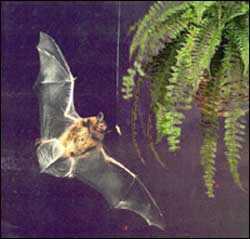New research shows bats have complex skills to deal with ’clutter’

Echolocating bats adjust their vocalizations to catch insects against a changing environmental background. (Photo: Steven Dear)
A little clutter on the way to the refrigerator might mean taking a few extra seconds to navigate your way to a late night snack. For a bat flying around in the dark searching for a meal of insects, the “clutter” of things like leaves and trees could mean missing out on a tasty morsel of dinner altogether.
A bat finds its way around with sound rather than sight. Using a sensory process called echolocation, the bat emits ultrasonic pulses that hit objects like leaves, trees, and insects, and bounce back to the bat to tell it what’s in the vicinity. When an echo returns from “clutter” at the same time a sound bounces back from an insect, the bat has a real challenge figuring out where the bug is.
In an article published in the open access journal PLoS Biology, University of Maryland psychology professor Cynthia Moss reports on new research that shows bats have methods for echolocating food in “clutter” that may be more complex than scientists have thought.
In its hunt for prey, a bat flies around at high speeds, emitting pulses of varying pitches and speeds. Using an array of high-speed infrared cameras and strategically placed microphones in the “Batlab,” Moss’s team was able to match slowed video and audio recordings of the bat’s echolocation activity and corresponding movement as it pursued an insect tethered to a string. The insect could be out in the open, or nestled in among leaves.
“We have found that bats adjust the timing of their sounds when they encounter clutter, and they seem to ’strobe’ the world with sound,” says Moss. As the bat gets closer to what could be an insect, it sends out an array of quick repetitive pulses, called sonar strobe groups. Finally, when it has locked onto the bug, right before scooping it up, the bat shoots a rapid fire series of sounds called the final buzz.
“In each case we found that the bats spent more time strobing when the insect was positioned near a plant, a strong indication that they used sonar strobe groups to try to distinguish the insect from the background clutter,” Moss says. “They also varied the intervals between pulses in the strobe group, depending on the distance between the prey and clutter.”
“Most importantly,” says Moss, “the results of this study clearly show that bats control the timing of their calls to directly influence the patterns of echoes used for perception.” This work nicely highlights a growing body of evidence from a variety of species, including humans, for the necessity of active participation in sensing the world.
Media Contact
All latest news from the category: Life Sciences and Chemistry
Articles and reports from the Life Sciences and chemistry area deal with applied and basic research into modern biology, chemistry and human medicine.
Valuable information can be found on a range of life sciences fields including bacteriology, biochemistry, bionics, bioinformatics, biophysics, biotechnology, genetics, geobotany, human biology, marine biology, microbiology, molecular biology, cellular biology, zoology, bioinorganic chemistry, microchemistry and environmental chemistry.
Newest articles

Superradiant atoms could push the boundaries of how precisely time can be measured
Superradiant atoms can help us measure time more precisely than ever. In a new study, researchers from the University of Copenhagen present a new method for measuring the time interval,…

Ion thermoelectric conversion devices for near room temperature
The electrode sheet of the thermoelectric device consists of ionic hydrogel, which is sandwiched between the electrodes to form, and the Prussian blue on the electrode undergoes a redox reaction…

Zap Energy achieves 37-million-degree temperatures in a compact device
New publication reports record electron temperatures for a small-scale, sheared-flow-stabilized Z-pinch fusion device. In the nine decades since humans first produced fusion reactions, only a few fusion technologies have demonstrated…





















